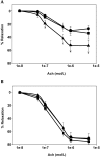Ribonucleotide reductase inhibitors reduce atherosclerosis in a double-injury rabbit model
- PMID: 20034432
- PMCID: PMC2798842
Ribonucleotide reductase inhibitors reduce atherosclerosis in a double-injury rabbit model
Abstract
Atheroproliferative disorders such as atherosclerosis are an important health problem and one of the leading causes of morbidity and mortality in the United States. Minimally invasive therapeutic procedures, including angioplasty with stent deployment, are used frequently for obstructive coronary artery disease. However, restenosis, a proliferative vascular response, is a common sequela to this procedure. The current study investigated the effect of inhibiting ribonucleotide reductase (RR), an enzyme necessary for cellular proliferation, in an attempt to ameliorate the proliferative response. Two RR inhibitors, didox and hydroxyurea, were chosen for their potent antiproliferative properties. Studies were carried out by using a double-injury rabbit model, in which endothelial denudation was followed by the administration of a high-fat diet. At 4 wk after initial endothelial denudation, the developing atherosclerotic lesion was subjected to transluminal balloon dilation to simulate clinical intervention with percutaneous transluminal angioplasty. The degree of restenosis and atheroproliferation was assessed at 8 wk. Histologic evaluation of the lesion demonstrated that treatment with didox and hydroxyurea significantly decreased lesion area and lumen loss. These results suggest that RR inhibition may be an effective new tool for the treatment of atheroproliferative disorders.
Figures



Similar articles
-
Inhibition of ribonucleotide reductase reduces neointimal formation following balloon injury.J Pharmacol Exp Ther. 2005 Jul;314(1):70-6. doi: 10.1124/jpet.105.083980. Epub 2005 Apr 6. J Pharmacol Exp Ther. 2005. PMID: 15814568
-
Interaction of gallium nitrate with other inhibitors of ribonucleotide reductase: effects on the proliferation of human leukemic cells.Cancer Lett. 1998 Jul 17;129(2):199-204. doi: 10.1016/s0304-3835(98)00104-9. Cancer Lett. 1998. PMID: 9719462
-
Ribonucleotide reductase inhibitors enhance cidofovir-induced apoptosis in EBV-positive nasopharyngeal carcinoma xenografts.Int J Cancer. 2005 Sep 10;116(4):640-5. doi: 10.1002/ijc.21096. Int J Cancer. 2005. PMID: 15818619
-
The enzyme ribonucleotide reductase: target for antitumor and anti-HIV therapy.Crit Rev Clin Lab Sci. 1997;34(6):503-28. doi: 10.3109/10408369709006424. Crit Rev Clin Lab Sci. 1997. PMID: 9439883 Review.
-
Evolving role of ribonucleoside reductase inhibitors in hematologic malignancies.Expert Rev Anticancer Ther. 2002 Aug;2(4):437-48. doi: 10.1586/14737140.2.4.437. Expert Rev Anticancer Ther. 2002. PMID: 12647987 Review.
Cited by
-
Targeting the Cell Cycle, RRM2 and NF-κB for the Treatment of Breast Cancers.Cancers (Basel). 2024 Feb 28;16(5):975. doi: 10.3390/cancers16050975. Cancers (Basel). 2024. PMID: 38473336 Free PMC article.
-
Thioredoxin and thioredoxin target proteins: from molecular mechanisms to functional significance.Antioxid Redox Signal. 2013 Apr 1;18(10):1165-207. doi: 10.1089/ars.2011.4322. Epub 2012 Jun 26. Antioxid Redox Signal. 2013. PMID: 22607099 Free PMC article. Review.
-
Hydroxyurea ameliorates atherosclerosis in ApoE-/- mice by potentially modulating Niemann-Pick C1-like 1 protein through the gut microbiota.Theranostics. 2022 Nov 14;12(18):7775-7787. doi: 10.7150/thno.76805. eCollection 2022. Theranostics. 2022. PMID: 36451858 Free PMC article.
-
The efficacy of the ribonucleotide reductase inhibitor Didox in preclinical models of AML.PLoS One. 2014 Nov 17;9(11):e112619. doi: 10.1371/journal.pone.0112619. eCollection 2014. PLoS One. 2014. PMID: 25402485 Free PMC article.
References
-
- Beyar R. 2004. Novel approaches to reduce restenosis. Ann N Y Acad Sci 1015:367–378 - PubMed
-
- Drachman DE, Edelman ER, Seifert P, Groothuis AR, Bornstein DA, Kamath KR, Palasis M, Yang D, Nott SH, Rogers C. 2000. Neointimal thickening after stent delivery of paclitaxel: change in composition and arrest of growth over 6 months. J Am Coll Cardiol 36:2325–2332 - PubMed
-
- Duilio C, Ambrosio G, Kuppusamy P, DiPaula A, Becker LC, Zweier JL. 2001. Neutrophils are primary source of O2 radicals during reperfusion after prolonged myocardial ischemia. Am J Physiol Heart Circ Physiol 280:H2649–H2657 - PubMed
-
- Elezi S, Kastrati A, Neumann FJ, Hadamitzky M, Dirschinger J, Schomig A. 1998. Vessel size and long-term outcome after coronary stent placement. Circulation 98:1875–1880 - PubMed
MeSH terms
Substances
LinkOut - more resources
Full Text Sources
Other Literature Sources
Medical
